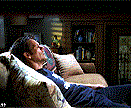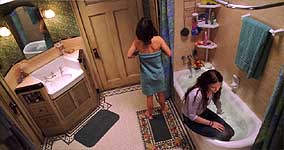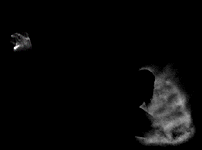
The two floating chair shots seemed pretty straightforward: they were both shot as lockoffs with the chair attached to the greenscreen-draped boom of a small camera crane and with a separate clean background plate. However, a slightly loose gate in the camera kept the shot from being completely steady, so in addition to hand-rotoscoping the parts of the chair hidden in the shadows, artists Martha Soehendra and Hitoshi Inoue also had to contend with steadying the images via motion tracking and synching up the strobing lights which were used to simulate the flicker of the projection on the set. The film projection of the words "SLEEP" and "DIG" were projected and racked in and out of focus on the set, with BFTR supplying the production with 1000-foot reels of the text shot on an animation stand.
For a quartet of hallucinatory flashcuts showing Samantha flailing on the couch, Todd took selected pieces of the undercranked greenscreen footage of Jennifer and managed to pull mattes from her blurring and streaking form using After Effects and composite her onto a couch background plate.
Digitally-created breath and vapor elements became a key component in the film as well, but for a narrative purpose. Unlike several other recent films that used visible breath to indicate the presence of ghosts who chill the room, David wanted to play upon the idea that Samantha had died when the weather was cold, so BFTR added digital breath elements --created in After Effects using MetaCreations' Particle World plug-in-- only to Samantha or to Tom when he is in her flashbacks. Although it was quite cold in Chicago through much of the September and October shoot, there proved to be surprisingly little opportunity to shoot the breath for real. As a result, there were almost a dozen shot incorporating the CG breath, ranging from shots of Samantha talking outside on the day of her death to shots of Tom inside the "flashback" living room or in the basement as he experiences her death, with each shot requiring extensive tracking and roto to put it into the scene. Integral to our composites was Puffin Designs' set of After Effects plug-ins, called Composite Wizard. Especially useful were the Light Wrap and Color Matcher filters, which helped all of our comps look more realistic.
Banned From The Ranch Entertainment Home Page ����General Information: info@bftr.com |


 For one of the film's big scares, the ghost of Samantha (Jennifer Morrison) appears on the couch next to Tom (Kevin Bacon). In addition to the greenscreen composite, Todd digitally altered the actress' eyeline so it would appear as she were looking straight at Tom.
For one of the film's big scares, the ghost of Samantha (Jennifer Morrison) appears on the couch next to Tom (Kevin Bacon). In addition to the greenscreen composite, Todd digitally altered the actress' eyeline so it would appear as she were looking straight at Tom.
